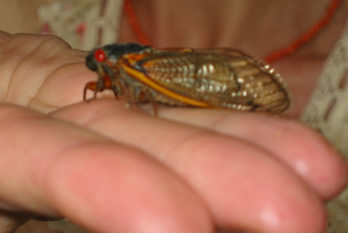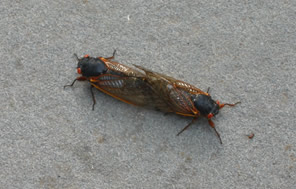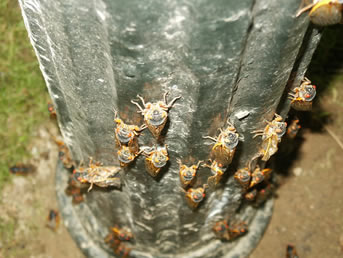
Bumping Uglies
Cicadas have really amazing life cycles both the annual
cicada and periodical cicada. Cicada males make their very
 distinctive
whining noise in order to attract a mate. They produce this
unique noise by rubbing together a pair of rigid membranes
together. The abdomen of male Cicada is hollow and it's believed
that it acts as a resonating chamber and that is part of the
reason why they can create their deafening sound.
distinctive
whining noise in order to attract a mate. They produce this
unique noise by rubbing together a pair of rigid membranes
together. The abdomen of male Cicada is hollow and it's believed
that it acts as a resonating chamber and that is part of the
reason why they can create their deafening sound.
The female Cicada lets the male know she is interested by a serious of wing flaps. Once the male hears the female's wing flap he then begins to start signal calling in order to locate the flicking female. Once he locates the female they mount the female, (sometimes facing opposite directions and sometimes the same direction). After mating, the female cuts tiny slits into a twig on the tree, using a saw like egg laying structure called an ovipositer, and deposits her eggs. Cicadas can lay several hundreds of eggs. Once the nymphs hatch they fall to the ground and burrow into the soil. Cicadas live most of their lives as nymphs. They only live about two-four weeks as adults.
Annual Cicadas

Annual Cicadas have a lifespan that range from 2-5 years. As they go through several growth stages and molt, they may burrow several feet down. Full grown nymphs emerge from underground at night and leave small, half inch, holes behind them. They come out in the "dog days" of July and August and that is how they got the common name, Dog Day Cicada. Once above ground they climb the nearest vertical object and molt for the last emerging as an adult. The nymph casing is left clinging to the tree and the adult looks almost transparent before the exoskeleton hardens and gives the Annual Cicada its green and black color.
The more famous Periodical Cicada, has a little more interesting lifestyle because they have either a 13 or 17 year long lifestyles. They emergence of the nymphs is tightly synchronized so that most of the nymphs emerge within a few nights of each other. Because of this they come out from the ground in such huge numbers in order to overwhelm predators.
